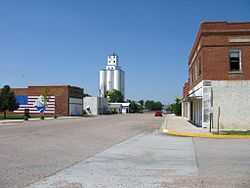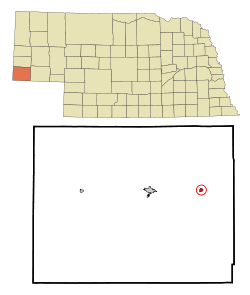Dix, Nebraska
| Dix, Nebraska | |
|---|---|
| Village | |
 | |
 Location of Dix, Nebraska | |
| Coordinates: 41°14′1″N 103°29′13″W / 41.23361°N 103.48694°WCoordinates: 41°14′1″N 103°29′13″W / 41.23361°N 103.48694°W | |
| Country | United States |
| State | Nebraska |
| County | Kimball |
| Area[1] | |
| • Total | 0.22 sq mi (0.57 km2) |
| • Land | 0.22 sq mi (0.57 km2) |
| • Water | 0 sq mi (0 km2) |
| Elevation | 4,554 ft (1,388 m) |
| Population (2010)[2] | |
| • Total | 255 |
| • Estimate (2012[3]) | 255 |
| • Density | 1,159.1/sq mi (447.5/km2) |
| Time zone | Mountain (MST) (UTC-7) |
| • Summer (DST) | MDT (UTC-6) |
| ZIP code | 69133 |
| Area code(s) | 308 |
| FIPS code | 31-13190 |
| GNIS feature ID | 0828736[4] |
Dix is a village in Kimball County, Nebraska, United States. The population was 255 at the 2010 census.
History
Dix was founded in 1886.[5] It was named after Dixon, Illinois, the former home of an early settler.[6][7]
Geography
Dix is located at 41°14′1″N 103°29′13″W / 41.23361°N 103.48694°W (41.233720, -103.486904).[8]
According to the United States Census Bureau, the village has a total area of 0.22 square miles (0.57 km2), all of it land.[1]
Demographics
| Historical population | |||
|---|---|---|---|
| Census | Pop. | %± | |
| 1920 | 248 | — | |
| 1930 | 279 | 12.5% | |
| 1940 | 199 | −28.7% | |
| 1950 | 270 | 35.7% | |
| 1960 | 420 | 55.6% | |
| 1970 | 342 | −18.6% | |
| 1980 | 275 | −19.6% | |
| 1990 | 229 | −16.7% | |
| 2000 | 267 | 16.6% | |
| 2010 | 255 | −4.5% | |
| Est. 2012 | 255 | 0.0% | |
| U.S. Decennial Census[9] 2012 Estimate[10] | |||
2010 census
As of the census[2] of 2010, there were 255 people, 103 households, and 74 families residing in the village. The population density was 1,159.1 inhabitants per square mile (447.5/km2). There were 119 housing units at an average density of 540.9 per square mile (208.8/km2). The racial makeup of the village was 95.3% White, 2.0% Native American, 1.2% Asian, 0.8% from other races, and 0.8% from two or more races. Hispanic or Latino of any race were 4.3% of the population.
There were 103 households of which 35.9% had children under the age of 18 living with them, 54.4% were married couples living together, 5.8% had a female householder with no husband present, 11.7% had a male householder with no wife present, and 28.2% were non-families. 24.3% of all households were made up of individuals and 10.7% had someone living alone who was 65 years of age or older. The average household size was 2.48 and the average family size was 2.86.
The median age in the village was 38.8 years. 26.3% of residents were under the age of 18; 5.4% were between the ages of 18 and 24; 26% were from 25 to 44; 24.3% were from 45 to 64; and 18% were 65 years of age or older. The gender makeup of the village was 51.0% male and 49.0% female.
2000 census
As of the census of 2000, there were 267 people, 107 households, and 71 families residing in the village. The population density was 1,224.0 people per square mile (468.6/km²). There were 112 housing units at an average density of 513.4 per square mile (196.6/km²). The racial makeup of the village was 97.00% White, 3.00% from other races. Hispanic or Latino of any race were 4.12% of the population.
There were 107 households out of which 30.8% had children under the age of 18 living with them, 57.9% were married couples living together, 6.5% had a female householder with no husband present, and 33.6% were non-families. 28.0% of all households were made up of individuals and 14.0% had someone living alone who was 65 years of age or older. The average household size was 2.50 and the average family size was 3.07.
In the village the population was spread out with 27.3% under the age of 18, 8.6% from 18 to 24, 24.3% from 25 to 44, 24.3% from 45 to 64, and 15.4% who were 65 years of age or older. The median age was 38 years. For every 100 females there were 107.0 males. For every 100 females age 18 and over, there were 92.1 males.
As of 2000 the median income for a household in the village was $31,094, and the median income for a family was $34,167. Males had a median income of $25,625 versus $20,000 for females. The per capita income for the village was $15,997. About 6.9% of families and 9.9% of the population were below the poverty line, including 5.7% of those under the age of eighteen and 4.4% of those sixty five or over.
References
- ↑ 1.0 1.1 "US Gazetteer files 2010". United States Census Bureau. Retrieved 2012-06-24.
- ↑ 2.0 2.1 "American FactFinder". United States Census Bureau. Retrieved 2012-06-24.
- ↑ "Population Estimates". United States Census Bureau. Retrieved 2013-05-29.
- ↑ "US Board on Geographic Names". United States Geological Survey. 2007-10-25. Retrieved 2008-01-31.
- ↑ "Dix, Kimball County". Center for Advanced Land Management Information Technologies. University of Nebraska. Retrieved 18 August 2014.
- ↑ Shumway, Grant Lee (1921). History of Western Nebraska and Its People. Western publishing & engraving Company. p. 336.
- ↑ "Profile for Dix, NE". ePodunk. Retrieved 18 August 2014.
- ↑ "US Gazetteer files: 2010, 2000, and 1990". United States Census Bureau. 2011-02-12. Retrieved 2011-04-23.
- ↑ United States Census Bureau. "Census of Population and Housing". Retrieved October 19, 2013.
- ↑ "Annual Estimates of the Resident Population: April 1, 2010 to July 1, 2012". Retrieved October 19, 2013.
| |||||||||||||||||||||